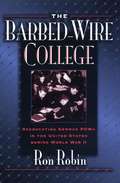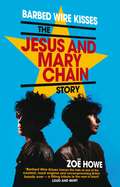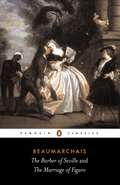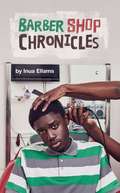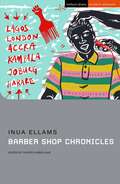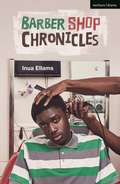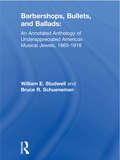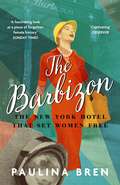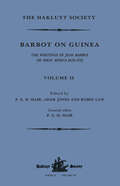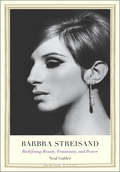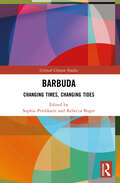- Table View
- List View
The Barbed-Wire College: Reeducating German POWs in the United States During World War II
by Ron Theodore RobinFrom Stalag 17 to The Manchurian Candidate, the American media have long been fascinated with stories of American prisoners of war. But few Americans are aware that enemy prisoners of war were incarcerated on our own soil during World War II. In The Barbed-Wire College Ron Robin tells the extraordinary story of the 380,000 German prisoners who filled camps from Rhode Island to Wisconsin, Missouri to New Jersey. Using personal narratives, camp newspapers, and military records, Robin re-creates in arresting detail the attempts of prison officials to mold the daily lives and minds of their prisoners.From 1943 onward, and in spite of the Geneva Convention, prisoners were subjected to an ambitious reeducation program designed to turn them into American-style democrats. Under the direction of the Pentagon, liberal arts professors entered over 500 camps nationwide. Deaf to the advice of their professional rivals, the behavioral scientists, these instructors pushed through a program of arts and humanities that stressed only the positive aspects of American society. Aided by German POW collaborators, American educators censored popular books and films in order to promote democratic humanism and downplay class and race issues, materialism, and wartime heroics. Red-baiting Pentagon officials added their contribution to the program, as well; by the war's end, the curriculum was more concerned with combating the appeals of communism than with eradicating the evils of National Socialism.The reeducation officials neglected to account for one factor: an entrenched German military subculture in the camps, complete with a rigid chain of command and a propensity for murdering "traitors." The result of their neglect was utter failure for the reeducation program. By telling the story of the program's rocky existence, however, Ron Robin shows how this intriguing chapter of military history was tied to two crucial episodes of twentieth- century American history: the battle over the future of American education and the McCarthy-era hysterics that awaited postwar America.
Barbed Wire Disease: British & German Prisoners of War, 1914-19
by John YarnallBy the time of the Armistice in 1918, some 6.5 million prisoners of war were held by the belligerents. Little has been written about these prisoners, possibly because the story is not one of unmitigated hardship and cruelty. Nevertheless, hardships did occur and the alleged neglect and ill-treatment of prisoners captured on the Western Front became the subject of major propaganda campaigns in Britain and Germany as the war progressed. 'Barbed Wire Disease' looks at the conditions facing those prisoners and the claims and counter-claims relating to their treatment. At the same time, it sets the story in the wider context of the commitment by both governments to treat prisoners humanely in accordance with the recently agreed Hague and Geneva Conventions. The political and diplomatic efforts to achieve this are examined in detail, and it concludes by examining the failed first-ever efforts to bring war criminals to justice before international tribunals.
Barbed Wire Heart
by Tess SharpeThis powerful debut thriller from "a major new talent" (Kirkus) set in a poor, rural community where loyalty is everything, "packs an emotional punch" (Lisa Gardner) as the daughter of a meth kingpin is forced to choose between family, or freedom. Never cut the drugs--leave them pure. Guns are meant to be shot--keep them loaded. Family is everything--betray them and die. Harley McKenna is the only child of North County's biggest criminal. Duke McKenna's run more guns, cooked more meth, and killed more men than anyone around. Harley's been working for him since she was sixteen, dreading the day he'd deem her ready to rule the rural drug empire he's built. Her time's run out. The Springfields, her family's biggest rivals, are moving in. And they're coming for Duke's only weak spot: his daughter. Duke's raised her to be deadly -- he never counted on her being disloyal. But if Harley wants to survive and protect the people she loves, she's got to take out both Duke's operation and the Springfields. Blowing up meth labs is dangerous business, and getting caught will be the end of her, but Harley has one advantage: She is her father's daughter. And McKennas always win.
Barbed Wire Kisses: The Jesus and Mary Chain Story
by Zoë HoweThe Mary Chain were the best thing since punk rock' - Bobby Gillespie 'The Jesus and Mary Chain were integral to my musical development' - Trent Reznor, Nine Inch Nails Praise for Zoë Howe: 'A stunning reinvention of the rock memoir format. Zoë Howe bottles Wilko's lightning' - Dave Collins, Vive Le Rock, on Wilko Johnson: Looking Back at Me 'Brit-rock book of the year' - Gavin Martin on Typical Girls? The Story of The Slits Musically, culturally and in terms of sheer attitude, The Jesus and Mary Chain stand alone. Their seminal debut album Psychocandy would change the course of popular music, and their distinctive blend of psychotic white noise, dark lyrics and a pop sensibility continues to enchant and confound to this day. This book takes us behind the wall of distortion to reveal the fierce, frank and often funny tale of The Jesus and Mary Chain, told by the band members and their associates for the first time. Author Zoë Howe charts each step of the Mary Chain's journey up to the present day, chronicling the formation of the group, their incendiary live performances, the Reids' powerful songcraft and those famous fraternal tensions that would prepare Creation Records boss Alan McGee for the onslaught of the Gallaghers. Thirty years after the Mary Chain formed, it is time this influential group and sometime 'public enemy' had their say. Includes new and exclusive interviews with Jim Reid, Douglas Hart, Bobby Gillespie, Alan McGee, Murray Dalglish, Laurence Verfaillie, John Moore, Ben Lurie, Stephen Pastel and many others.
The Barber of Damascus: Nouveau Literacy in the Eighteenth-Century Ottoman Levant
by Dana SajdiThis book is about a barber, Shihab al-Din Ahmad Ibn Budayr, who shaved and coiffed, and probably circumcised and healed, in Damascus in the 18th century. The barber may have been a "nobody," but he wrote a history book, a record of the events that took place in his city during his lifetime. Dana Sajdi investigates the significance of this book, and in examining the life and work of Ibn Budayr, uncovers the emergence of a larger trend of history writing by unusual authors—people outside the learned establishment—and a new phenomenon: nouveau literacy. The Barber of Damascus offers the first full-length microhistory of an individual commoner in Ottoman and Islamic history. Contributing to Ottoman popular history, Arabic historiography, and the little-studied cultural history of the 18th century Levant, the volume also examines the reception of the barber's book a century later to explore connections between the 18th and the late 19th centuries and illuminates new paths leading to the Nahda, the Arab Renaissance.
The Barber of Seville and The Marriage of Figaro: The Barber Of Seville, The Marriage Of Figaro, And The Guilty Mother (Penguin Classics Series)
by Pierre-Augustin BeaumarchaisA French courtier, secret agent, libertine and adventurer, Beaumarchais (1732-99) was also author of two sparkling plays about the scoundrelly valet Figaro - triumphant successes that were used as the basis of operas by Mozart and Rossini. A highly engaging comedy of intrigue, The Barber of Seville portrays the resourceful Figaro foiling a jealous old man's attempts to keep his beautiful ward from her lover. And The Marriage of Figaro - condemned by Louis XVI for its daring satire of nobility and privilege - depicts a master and servant set in opposition by their desire for the same woman. With characteristic lightness of touch, Beaumarchais created an audacious farce of disguise and mistaken identity that balances wit, frivolity and seriousness in equal measure.
Barber Shop Chronicles (Oberon Modern Plays)
by Inua EllamsOne day. Six cities. A thousand stories. Newsroom, political platform, local hot spot, confession box, preacher-pulpit and football stadium. For generations, African men have gathered in barber shops to discuss the world.
Barber Shop Chronicles (Student Editions)
by Inua EllamsNewsroom, political platform, local hot spot, confession box, preacher-pulpit and football stadium. For generations, African men have gathered in barber shops to discuss the world. These are places where the banter can be barbed and the truth is always telling.Barber Shop Chronicles, which was partly inspired by verbatim recordings, is a heart-warming, hilarious and insightful play that leaps from a barber shop in Peckham to Johannesburg, Harare, Kampala, Lagos and Accra over the course of a single day.It was first produced by the National Theatre, Fuel and Leeds Playhouse in 2017 and is here publishedas a Methuen Drama Student Edition with commentary and notes by Oladipo Agboluaje.
Barber Shop Chronicles (Modern Plays)
by Inua EllamsBarber Shop Chronicles is a generously funny, heart-warming and insightful new play set in five African cities, Johannesburg, Harare, Kampala, Lagos, Accra, and in London.Inspired in part by the story of a Leeds barber, the play invites the audience into a unique environment where the banter may be barbed, but the truth always telling. The barbers of these tales are sages, role models and father figures who keep the men together and the stories alive.Inua Ellams's celebrated play was first produced by the National Theatre, Fuel and Leeds Playhouse in 2017.
Barber Shop Chronicles (Modern Plays)
by Inua EllamsBarber Shop Chronicles is a generously funny, heart-warming and insightful new play set in five African cities, Johannesburg, Harare, Kampala, Lagos, Accra, and in London.Inspired in part by the story of a Leeds barber, the play invites the audience into a unique environment where the banter may be barbed, but the truth always telling. The barbers of these tales are sages, role models and father figures who keep the men together and the stories alive.Inua Ellams's celebrated play was first produced by the National Theatre, Fuel and Leeds Playhouse in 2017.
Barber Shop Chronicles (Student Editions)
by Inua EllamsNewsroom, political platform, local hot spot, confession box, preacher-pulpit and football stadium. For generations, African men have gathered in barber shops to discuss the world. These are places where the banter can be barbed and the truth is always telling.Barber Shop Chronicles, which was partly inspired by verbatim recordings, is a heart-warming, hilarious and insightful play that leaps from a barber shop in Peckham to Johannesburg, Harare, Kampala, Lagos and Accra over the course of a single day.It was first produced by the National Theatre, Fuel and Leeds Playhouse in 2017 and is here publishedas a Methuen Drama Student Edition with commentary and notes by Oladipo Agboluaje.
The Barber's Clever Wife: A Bloomsbury Reader (Bloomsbury Readers)
by Narinder DhamiA funny retelling of an Indian folk tale from best-selling author Narinder Dhami.Bulbul would much rather sit at home under the mango tree than go to work. And anyway everyone in the village agrees that he is the worst barber in the whole world. Luckily his wife Ruby has a cunning plan to earn money – but first they must outwit a notorious band of thieves!This comical version of a traditional Indian story from best-selling author Narinder Dhami has entertaining black-and-white illustrations by TBC and is perfect for children who are developing as readers. The Bloomsbury Readers series is packed with brilliant books to get children reading independently in Key Stage 2, with book-banded stories by award-winning authors like double Carnegie Medal winner Geraldine McCaughrean and Waterstones Prize winner Patrice Lawrence, covering a wide range of genres and topics. With charming illustrations and online guided reading notes written by the Centre for Literacy in Primary Education (CLPE), this series is ideal for reading both in the classroom and at home. For more information visit www.bloomsburyguidedreading.com.Book Band: BrownIdeal for ages 8+
The Barber's Clever Wife: A Bloomsbury Reader (Bloomsbury Readers)
by Narinder DhamiA funny retelling of an Indian folk tale from best-selling author Narinder Dhami.Bulbul would much rather sit at home under the mango tree than go to work. And anyway everyone in the village agrees that he is the worst barber in the whole world. Luckily his wife Ruby has a cunning plan to earn money – but first they must outwit a notorious band of thieves!This comical version of a traditional Indian story from best-selling author Narinder Dhami has entertaining black-and-white illustrations by TBC and is perfect for children who are developing as readers. The Bloomsbury Readers series is packed with brilliant books to get children reading independently in Key Stage 2, with book-banded stories by award-winning authors like double Carnegie Medal winner Geraldine McCaughrean and Waterstones Prize winner Patrice Lawrence, covering a wide range of genres and topics. With charming illustrations and online guided reading notes written by the Centre for Literacy in Primary Education (CLPE), this series is ideal for reading both in the classroom and at home. For more information visit www.bloomsburyguidedreading.com.Book Band: BrownIdeal for ages 8+
Barbershops, Bibles, and BET: Everyday Talk and Black Political Thought
by Melissa Victoria Harris-LacewellWhat is the best way to understand black political ideology? Just listen to the everyday talk that emerges in public spaces, suggests Melissa Harris-Lacewell. And listen this author has--to black college students talking about the Million Man March and welfare, to Southern, black Baptists discussing homosexuality in the church, to black men in a barbershop early on a Saturday morning, to the voices of hip-hop music and Black Entertainment Television. Using statistical, experimental, and ethnographic methods Barbershops, Bibles, and B.E.T offers a new perspective on the way public opinion and ideologies are formed at the grassroots level. The book makes an important contribution to our understanding of black politics by shifting the focus from the influence of national elites in opinion formation to the influence of local elites and people in daily interaction with each other. Arguing that African Americans use community dialogue to jointly develop understandings of their collective political interests, Harris-Lacewell identifies four political ideologies that constitute the framework of contemporary black political thought: Black Nationalism, Black Feminism, Black Conservatism and Liberal Integrationism. These ideologies, the book posits, help African Americans to understand persistent social and economic inequality, to identify the significance of race in that inequality, and to devise strategies for overcoming it.
Barbershops, Bibles, and BET: Everyday Talk and Black Political Thought (PDF)
by Melissa Victoria Harris-LacewellWhat is the best way to understand black political ideology? Just listen to the everyday talk that emerges in public spaces, suggests Melissa Harris-Lacewell. And listen this author has--to black college students talking about the Million Man March and welfare, to Southern, black Baptists discussing homosexuality in the church, to black men in a barbershop early on a Saturday morning, to the voices of hip-hop music and Black Entertainment Television. Using statistical, experimental, and ethnographic methods Barbershops, Bibles, and B.E.T offers a new perspective on the way public opinion and ideologies are formed at the grassroots level. The book makes an important contribution to our understanding of black politics by shifting the focus from the influence of national elites in opinion formation to the influence of local elites and people in daily interaction with each other. Arguing that African Americans use community dialogue to jointly develop understandings of their collective political interests, Harris-Lacewell identifies four political ideologies that constitute the framework of contemporary black political thought: Black Nationalism, Black Feminism, Black Conservatism and Liberal Integrationism. These ideologies, the book posits, help African Americans to understand persistent social and economic inequality, to identify the significance of race in that inequality, and to devise strategies for overcoming it.
Barbershops, Bullets, and Ballads: An Annotated Anthology of Underappreciated American Musical Jewels, 1865-1918
by William E Studwell Bruce R SchuenemanThrough Barbershops, Bullets, and Ballads: An Annotated Anthology of Underappreciated American Musical Jewels, 1865--1918, you will discover older musical gems written during a half-century period of geographical, economic, political, and cultural expansion in the United States. Due to the fact that our collective American consciousness is rapidly developing cultural amnesia about or indifference to many of these older songs, the authors felt that a scholarly anthology needed to be produced before another century and millennium overwhelmed us. With Barbershops, Bullets, and Ballads, you will discover academic composers such as Arthur Foote, George Chadwick, and Amy Beach and find annotations outlining the history of the songs as well as the actual words and music.Barbershops, Bullets, and Ballads reveals to you such underappreciated songs as: “Above in Her Chamber,” with music by Julius Eichberg and lyrics by poet Celia Thaxter “In the Evening by the Moonlight,” with music and lyrics by James A. Bland “My Wild Irish Rose,” with music and lyrics by Chauncey Olcott “Cheyenne,” by lyricist Harry H. Williams and composer Egbert Van Alstyne “Come, Josephine in My Flying Machine,” with music by Fred Fisher and lyrics by Alfred BryanIn Barbershops, Bullets, and Ballads, you will find sections containing historical notes of featured songs in chronological order. Through this remarkable collection, you will discover an anthology of popular music of the bygone “golden age” of song and take a pleasurable voyage back to a time that is long gone.
Barbershops, Bullets, and Ballads: An Annotated Anthology of Underappreciated American Musical Jewels, 1865-1918
by William E Studwell Bruce R SchuenemanThrough Barbershops, Bullets, and Ballads: An Annotated Anthology of Underappreciated American Musical Jewels, 1865--1918, you will discover older musical gems written during a half-century period of geographical, economic, political, and cultural expansion in the United States. Due to the fact that our collective American consciousness is rapidly developing cultural amnesia about or indifference to many of these older songs, the authors felt that a scholarly anthology needed to be produced before another century and millennium overwhelmed us. With Barbershops, Bullets, and Ballads, you will discover academic composers such as Arthur Foote, George Chadwick, and Amy Beach and find annotations outlining the history of the songs as well as the actual words and music.Barbershops, Bullets, and Ballads reveals to you such underappreciated songs as: “Above in Her Chamber,” with music by Julius Eichberg and lyrics by poet Celia Thaxter “In the Evening by the Moonlight,” with music and lyrics by James A. Bland “My Wild Irish Rose,” with music and lyrics by Chauncey Olcott “Cheyenne,” by lyricist Harry H. Williams and composer Egbert Van Alstyne “Come, Josephine in My Flying Machine,” with music by Fred Fisher and lyrics by Alfred BryanIn Barbershops, Bullets, and Ballads, you will find sections containing historical notes of featured songs in chronological order. Through this remarkable collection, you will discover an anthology of popular music of the bygone “golden age” of song and take a pleasurable voyage back to a time that is long gone.
Barbie Culture
by Professor Mary F. RogersThis book uses one of the most popular accessories of childhood, the Barbie doll, to explain key aspects of cultural meaning. Some readings would see Barbie as reproducing ethnicity and gender in a particularly coarse and damaging way - a cultural icon of racism and sexism. Rogers develops a broader, more challenging picture. She shows how the cultural meaning of Barbie is more ambiguous than the narrow, appearance-dominated model that is attributed to the doll. For a start, Barbie's sexual identity is not clear-cut. Similarly her class situation is ambiguous. But all interpretations agree that, with her enormous range of lifestyle `accessories', Barbie exists to consume. Her body is the perfect metaphor of modern times: plastic, standardized and oozing fake sincerity.
The Barbier Reaction and Related One-Step Processes (Reactivity and Structure: Concepts in Organic Chemistry #31)
by Cornelis BlombergThe significant increase in applications of Barbier and Barbier-type reactions in (in-) organic synthesis over the past twenty-five years, combined with repeated stimulation on the part of Springer-Verlag (Dr. R. Stumpe) were strong in centives for me to write this book. My earliest activities in this field include a modest and first-ever review article (in cooperation with Dr. F. A. Hartog who at that time (1977) did his doctoral research on the Barbier reaction). References to this review article, as mentioned in the Science Citation Index till recently are a good indication for a continued interest in this simple synthetic procedure. The subtitle of this monograph, Related One-Step Processes, may require the following clarification. A synthesis with the aid of an organometallic compound is usually carried out in two steps: 1) the organometallic reagent is prepared from an organo halide and a metal in a solvent, 2) a chosen substrate is added to this reagent. In a Barbier reaction these two steps are combined: a mixture of the organo halide and the substrate is added to a suspension of the metal-in an appropriate solvent.
The Barbizon: The New York Hotel That Set Women Free
by Paulina Bren'Captivating... [explores] the changing cultural perceptions of women's ambition, set against the backdrop of that most famous theatre of aspiration, New York City' NEW YORK TIMESWELCOME TO THE BARBIZON, NEW YORK'S PREMIER WOMEN-ONLY HOTEL Built in 1927, New York's Barbizon Hotel was first intended as a home for the 'Modern Woman' seeking a career in the arts. It became the place to stay for ambitious, independent women, who were lured by the promise of fame and good fortune. Sylvia Plath fictionalized her time there in The Bell Jar, and over the years, its 688 tiny pink 'highly feminine boudoirs' also housed Joan Crawford, Grace Kelly (notorious for sneaking in men), Joan Didion, Candice Bergen, Charlie's Angel Jaclyn Smith, Ali MacGraw, Cybil Shepherd, Elaine Stritch, Liza Minnelli, Eudora Welty, The Cosby Show's Phylicia Rashad, and writers Mona Simpson and Ann Beattie, among many others. Mademoiselle boarded its summer interns there - perfectly turned-out young women, who would never be spotted hatless - as did Katherine Gibbs Secretarial School its students - in their white-gloves and kitten heels - and the Ford Modelling Agency its young models. Not everyone who passed through the Barbizon's doors was destined for greatness - for some it was a story of dashed hopes and expectations - but from the Jazz Age New Women of the 1920s, to the Liberated Women of the 1960s, until 1981 when the first men checked in, The Barbizon was a place where women could stand up and be counted. THE BARBIZON is a colourful, glamorous portrait of the lives of these young women, who came to New York looking for something more. It's a story of pushing the boundaries, of women's emancipation and of the generations of brilliant women who passed through its halls.
Barbot on Guinea: Volume II
by Adam JonesJean Barbot, who served as a commercial agent on French slave-trading voyages to West Africa in 1678-9 and 1681-2, in 1683 began an account of the Guinea coast, based partly on his voyage journals (only one of which is extant) and partly on previous printed sources. The work was interrupted by his flight to England, as a Huguenot refugee, in 1685, and not finished until 1688. When Barbot found that his lengthy French account could not be published, he rewrote it in English, enlarging it even further, and then continually revising it up to his death in 1712. The manuscript was eventually published in 1732. Barbot's book had considerable influence on later European attitudes to Black Africa and the Atlantic slave trade and in modern writings on both subjects is frequently cited as evidence. The French account serves as the base for the present edition and is presented in English translation but additional material in the later English version is inserted. The edition concentrates on Barbot's original information. He copied much from earlier sources - this derived material is omitted but is identified in the notes. The original material, mainly on Senegal, Sierra Leone, River Sess, Gold Coast and the Calabars, is extensively annotated, not least with comparative references to other sources. Apart from its narrative interest, the edition thus provides a starting point for the critical assessment of a range of early sources on Guinea. The edition opens with an introductory essay discussing Barbot's life and career and analysing his sources. Barbot provided a large number of his own drawings of topographical and ethnographical features, in particular drawings of almost all of the European forts in Guinea. Many of these illustrations are reproduced. This volume covers the coast from the River Volta to Cape Lopez. The main pagination of this and the previous volume (2nd series 175) series is continuous. This is a new print-on-demand hardback edition of the volume first published in 1991.
Barbot on Guinea: Volume II
by Adam JonesJean Barbot, who served as a commercial agent on French slave-trading voyages to West Africa in 1678-9 and 1681-2, in 1683 began an account of the Guinea coast, based partly on his voyage journals (only one of which is extant) and partly on previous printed sources. The work was interrupted by his flight to England, as a Huguenot refugee, in 1685, and not finished until 1688. When Barbot found that his lengthy French account could not be published, he rewrote it in English, enlarging it even further, and then continually revising it up to his death in 1712. The manuscript was eventually published in 1732. Barbot's book had considerable influence on later European attitudes to Black Africa and the Atlantic slave trade and in modern writings on both subjects is frequently cited as evidence. The French account serves as the base for the present edition and is presented in English translation but additional material in the later English version is inserted. The edition concentrates on Barbot's original information. He copied much from earlier sources - this derived material is omitted but is identified in the notes. The original material, mainly on Senegal, Sierra Leone, River Sess, Gold Coast and the Calabars, is extensively annotated, not least with comparative references to other sources. Apart from its narrative interest, the edition thus provides a starting point for the critical assessment of a range of early sources on Guinea. The edition opens with an introductory essay discussing Barbot's life and career and analysing his sources. Barbot provided a large number of his own drawings of topographical and ethnographical features, in particular drawings of almost all of the European forts in Guinea. Many of these illustrations are reproduced. This volume covers the coast from the River Volta to Cape Lopez. The main pagination of this and the previous volume (2nd series 175) series is continuous. This is a new print-on-demand hardback edition of the volume first published in 1991.
Barbra Streisand: Redefining Beauty, Femininity, and Power (Jewish Lives)
by Neal GablerBarbra Streisand has been called the “most successful...talented performer of her generation” by Vanity Fair, and her voice, said pianist Glenn Gould, is “one of the natural wonders of the age.” Streisand scaled the heights of entertainment—from a popular vocalist to a first-rank Broadway star in Funny Girl to an Oscar-winning actress to a producer and director. But she has also become a cultural icon who has transcended show business. To achieve her success, Brooklyn-born Streisand had to overcome tremendous odds, not the least of which was her Jewishness. Dismissed, insulted, even reviled when she embarked on a show business career for acting too Jewish and looking too Jewish, she brilliantly converted her Jewishness into a metaphor for outsiderness that would eventually make her the avenger for anyone who felt marginalized and powerless. Neal Gabler examines Streisand’s life and career through this prism of otherness—a Jew in a gentile world, a self-proclaimed homely girl in a world of glamour, a kooky girl in a world of convention—and shows how central it was to Streisand’s triumph as one of the voices of her age.
Barbuda: Changing Times, Changing Tides (Critical Climate Studies)
by Sophia Perdikaris Rebecca BogerThis volume explores a range of themes including impacts of climate change, resilience, sustainability, indigeneity, cultural genocide, disaster capitalism, preservation of biodiversity, and environmental degradation. Focusing on the island of Barbuda in the West Indies, it shares critical insights into how climate change is reshaping our world. The book examines how climate has changed in the Caribbean over different spatial and temporal scales and how varying natural and anthropogenic factors have shaped Barbuda’s climatic and cultural history. It highlights projections of 21st-century climate change for the Caribbean region and its likely impacts on Barbuda’s coastal ecosystems, potable groundwater resources, and heritage. With essays by researchers from the United States, Canada, Caribbean, and Europe, this volume straddles a range of disciplines such as archaeology, anthropology, paleoclimatology, environmental sciences, science education, and Traditional Ecological Knowledge (TEK). Drawing on interdisciplinary and transdisciplinary approaches that explore the intersection of natural and social systems over the longue durée, the volume will be of interest to scholars, researchers, and students of ethnography, social anthropology, climate action, development studies, public policy, and climate change.
Barbuda: Changing Times, Changing Tides (Critical Climate Studies)
by Sophia Perdikaris and Rebecca BogerThis volume explores a range of themes including impacts of climate change, resilience, sustainability, indigeneity, cultural genocide, disaster capitalism, preservation of biodiversity, and environmental degradation. Focusing on the island of Barbuda in the West Indies, it shares critical insights into how climate change is reshaping our world. The book examines how climate has changed in the Caribbean over different spatial and temporal scales and how varying natural and anthropogenic factors have shaped Barbuda’s climatic and cultural history. It highlights projections of 21st-century climate change for the Caribbean region and its likely impacts on Barbuda’s coastal ecosystems, potable groundwater resources, and heritage. With essays by researchers from the United States, Canada, Caribbean, and Europe, this volume straddles a range of disciplines such as archaeology, anthropology, paleoclimatology, environmental sciences, science education, and Traditional Ecological Knowledge (TEK). Drawing on interdisciplinary and transdisciplinary approaches that explore the intersection of natural and social systems over the longue durée, the volume will be of interest to scholars, researchers, and students of ethnography, social anthropology, climate action, development studies, public policy, and climate change.
